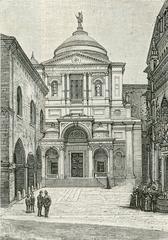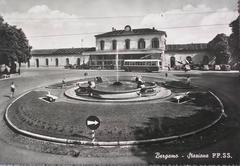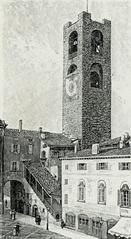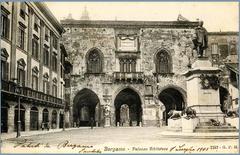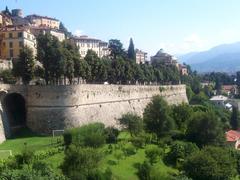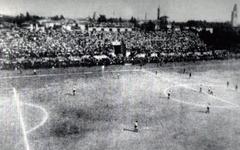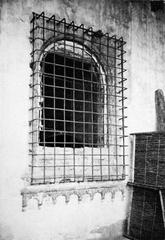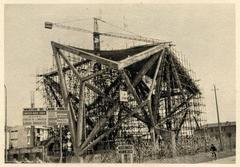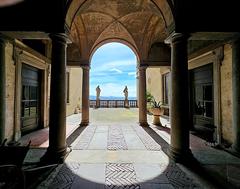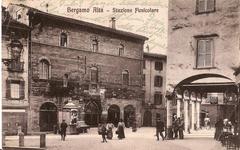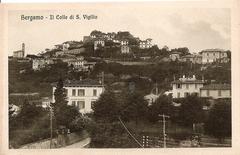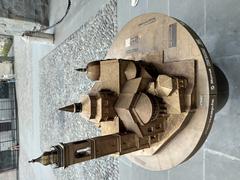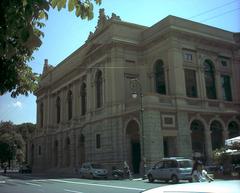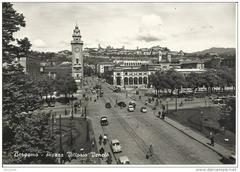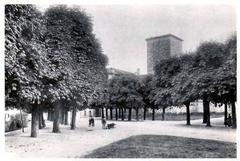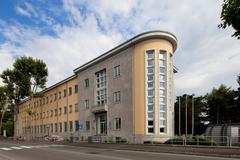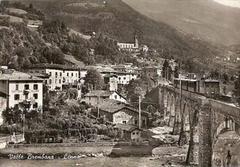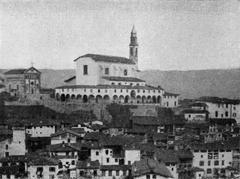Sant’Alessandro della Croce, Bergamo: Visiting Hours, Tickets, and Complete Visitor Guide
Date: 04/07/2025
Introduction
Sant’Alessandro della Croce stands as a testament to Bergamo’s rich religious, artistic, and civic heritage. Located in the historic Borgo Pignolo district, this Baroque masterpiece is not only dedicated to the city’s patron saint, Sant’Alessandro, but also functions as a dynamic center for community life, cultural events, and liturgical celebrations. This guide provides a detailed overview of the church’s history, architectural and artistic highlights, practical information for visitors—including visiting hours, ticketing, accessibility—and tips for an enriched experience among Bergamo’s historical sites (Parrocchia di Pignolo; Visit Bergamo; Lombardia Beni Culturali).
Historical Overview
Early Origins and Development
The origins of Sant’Alessandro della Croce are closely tied to the veneration of Sant’Alessandro, Bergamo’s patron saint. Tradition holds that a chapel was built soon after his martyrdom. The first documentary evidence of a church on this site dates to 1183, referenced as “Ecclesia Sancti Alexandri de Mugazone.” By 1244, it was known as “Ecclesia Sancti Alexandri de la cruce,” a name referencing the crossroads of Via Pignolo and Via Masone, which shaped its identity as a focal point for the community (Parrocchia di Pignolo).
Renaissance and Baroque Transformations
From the late 15th to the 18th century, the church underwent significant architectural changes. A major renovation at the end of the 15th century led to a probable reconsecration in 1517. Further expansions in the 16th and 17th centuries included new chapels, restoration of liturgical furnishings, and enhancements to the façade. By the late 17th century, the church was deemed too small for the congregation, prompting a complete Baroque reconstruction between 1676 and 1737 under the guidance of the Trezzini family of architects (Lombardia Beni Culturali).
Artistic Patronage
The church’s interior features an outstanding collection of frescoes, paintings, and sculptures by leading artists of the Bergamasque Renaissance and Baroque era. Notable contributors include Gian Battista Moroni, Andrea Fantoni, Giovan Paolo Cavagna, and Enea Salmeggia. The parish house, adjacent to the church, is adorned with a rare secular frieze of the Nine Muses, attributed to Cristoforo III Baschenis and possibly Giovan Battista Guarinoni (Le Terre dei Baschenis).
Religious and Cultural Significance
Sant’Alessandro della Croce is deeply embedded in Bergamo’s religious identity. The church’s dedication to Saint Alexander, a Christian martyr and soldier of the Theban Legion, links it directly to the city’s spiritual roots (Visit Bergamo). For centuries, the church has served as a focal point for major religious celebrations, including the feast day procession on August 26th, which enlivens the city with music, period costumes, and communal rituals.
Historically, leading families and local confraternities endowed and maintained chapels within the church, a tradition that fostered both religious and civic engagement. This enduring patronage is reflected in the church’s ongoing role as a venue for both liturgical and cultural events (BergamoNews).
Architectural and Artistic Highlights
Layout and Structure
Sant’Alessandro della Croce features a Latin cross plan with a single nave, short transept arms, and three chapels on each side. Its Baroque style is evident in the inventive spatial design, harmonious integration of painting, sculpture, and architecture, and elaborate ornamental details (Lombardia Beni Culturali).
Façade and Exterior
The church’s neoclassical façade, completed in 1923, provides a striking contrast to the richly decorated Baroque interior. Its narrow setting along Via Pignolo makes the façade a unique photographic subject (it.wikipedia.org).
Notable Artworks
- Gian Battista Moroni’s “Incoronazione della Vergine” (1576): Located on the counter-facade, this masterpiece exemplifies Moroni’s refined style.
- Moroni’s “Crocifissione con i Santi Sebastiano, Giovanni Battista e un devoto”: Displayed in the sacristy, it offers a moving depiction of saintly devotion.
- Andrea Fantoni’s Baroque Marble Altar (1729): The second chapel on the right showcases Fantoni’s intricate marble craftsmanship.
- Works by Cavagna, Salmeggia, and Previtali: These paintings enrich the church’s sacred artistic heritage.
- Antonio Sanz’s Confessionals and Manni’s Marble Relief: Exemplars of Lombard Baroque woodcarving and marble artistry.
The first chapel on the right preserves the urn that once held Saint Alexander’s relics, now enshrined in the Bergamo Cathedral (Visit Bergamo).
Visiting Sant’Alessandro della Croce: Practical Information
Visiting Hours
- Monday to Saturday: 8:00 AM – 12:00 PM, 3:00 PM – 7:00 PM
- Sunday: 10:00 AM – 12:00 PM (limited hours due to services)
- Note: Hours may vary on holidays or during special events. Always check the parish website or local tourist information before visiting.
Tickets and Admission
- Admission: Free
- Donations: Welcomed to support restoration and maintenance
Guided Tours
- Availability: By prior arrangement through the parish or local tourist offices
- Languages: Italian, with some guides available in English or French
- Recommendation: Booking in advance is advised, especially for groups or during peak tourist periods
Accessibility
- Wheelchair Access: Available via a side entrance and internal ramps
- Facilities: Accessible restrooms; brochures in multiple languages
- Note: The historic parish house may have limited accessibility
Travel Tips
- Getting There: Located in Borgo Pignolo, within walking distance from Bergamo Alta and the city center. Public transport and walking are recommended due to limited parking.
- Dress Code: Modest clothing required (shoulders and knees covered)
- Best Times to Visit: Early morning or late afternoon for a quieter experience and optimal lighting for photography
Special Events and Living Traditions
Sant’Alessandro della Croce is an active parish church hosting daily Mass, sacraments, and special liturgies—particularly on August 26th, the feast of Saint Alexander. The church also organizes classical music concerts, art lectures, and community gatherings, providing visitors with opportunities to experience Bergamo’s living cultural traditions (Diocesi di Bergamo).
Nearby Attractions
- Accademia Carrara: Renowned art gallery featuring Italian masterpieces (Accademia Carrara)
- GAMeC: Gallery of Modern and Contemporary Art
- Via Pignolo: Historic street with artisan shops and elegant palazzi
- Bergamo Cathedral, Basilica di Sant’Alessandro in Colonna, Piazza Vecchia, and Fontana del Delfino: All within easy walking distance, enriching your exploration of Bergamo’s historical core
Frequently Asked Questions (FAQ)
Q: What are the visiting hours for Sant’Alessandro della Croce?
A: Typically open from 8:00 AM to 12:00 PM and 3:00 PM to 7:00 PM, with reduced Sunday hours. Hours may vary during holidays or special events; check ahead for updates.
Q: Is there an entrance fee?
A: No, admission is free.
Q: Are guided tours available?
A: Yes, bookable in advance via the parish office or local tourism offices.
Q: Is the church wheelchair accessible?
A: Yes, accessible entrances and internal ramps are available.
Q: Can I take photographs inside?
A: Photography is generally permitted outside of liturgical services and restricted areas.
Q: Are there special events or concerts?
A: Yes, especially during the feast of Saint Alexander and throughout the year; see parish or city event listings for details.
Visitor Tips and Experiences
- Plan ahead: Confirm opening times, guided tour availability, and special events via official sources.
- Combine your visit: Explore nearby attractions such as the Accademia Carrara and Via Pignolo.
- Dress appropriately: Modest attire is required for entry.
- Accessibility: Facilities are available for visitors with disabilities.
Visitors often highlight the church’s serene ambiance, artistic treasures, and the contrast between its understated façade and opulent interior as standout aspects of their experience (Tripadvisor).
Summary and Call to Action
Sant’Alessandro della Croce encapsulates the spiritual, artistic, and communal legacy of Bergamo. With its remarkable Baroque interiors, masterpieces by renowned artists, and vibrant community events, the church is an essential destination for those exploring Bergamo’s historical sites. Free admission, accessibility, and proximity to other cultural landmarks make it ideal for both casual visitors and dedicated enthusiasts.
Plan your visit today:
- Download the Audiala app for up-to-date information, self-guided tours, and exclusive content.
- Follow us on social media for the latest news, event updates, and travel inspiration.
- Explore related articles for more insights on Bergamo’s architectural and artistic treasures.
References
- Sant’Alessandro della Croce in Bergamo: History, Art, and Visitor Guide to a Must-See Bergamo Historical Site, Parrocchia di Pignolo
- Visiting Sant’Alessandro della Croce: History, Tickets, Hours, and Bergamo’s Historical Sites, Visit Bergamo
- Sant’Alessandro della Croce: Visiting Hours, Tickets, and Artistic Highlights in Bergamo, Lombardia Beni Culturali
- Sant’Alessandro della Croce Visiting Hours, Tickets, and Guide to Bergamo Historical Sites, BergamoNews
- Accademia Carrara
- Tripadvisor
- Diocesi di Bergamo
- Le Terre dei Baschenis
